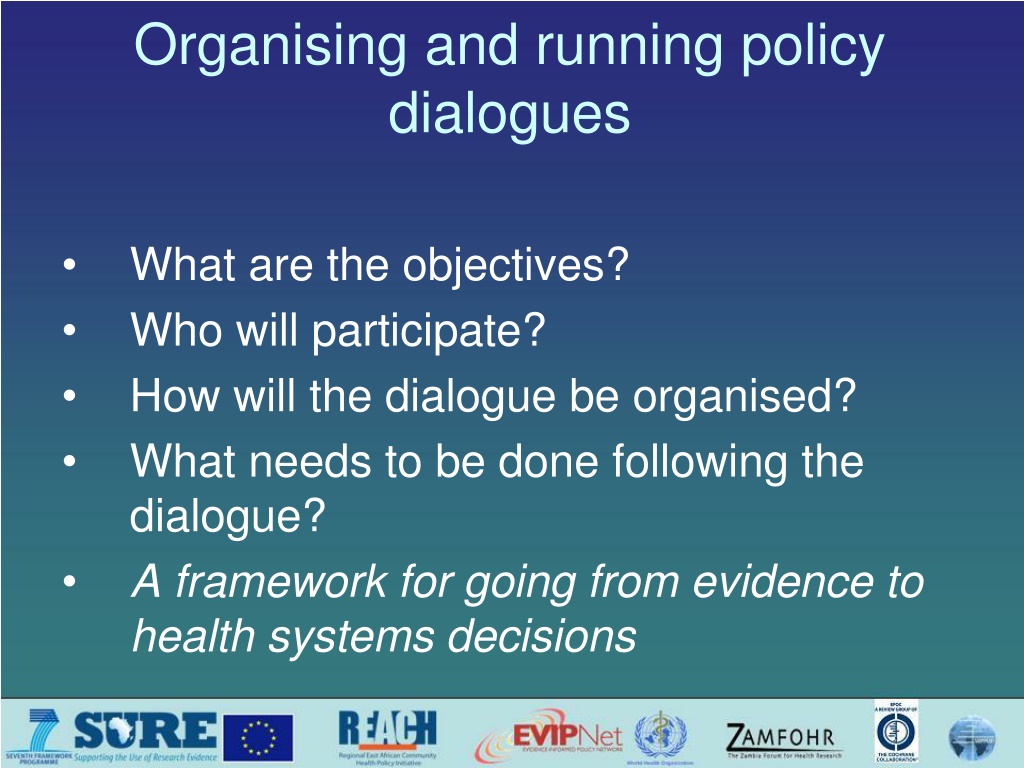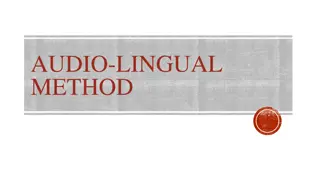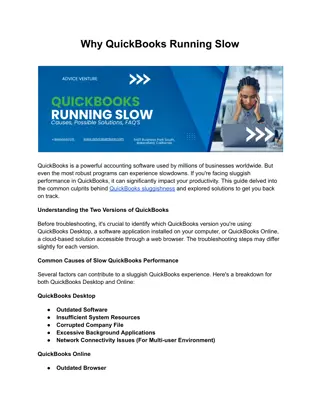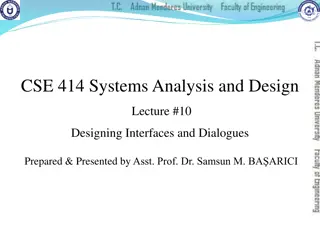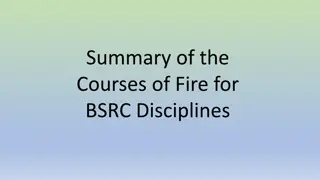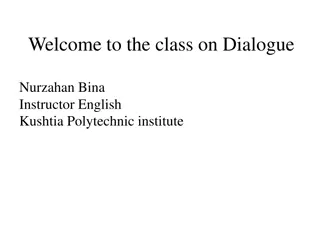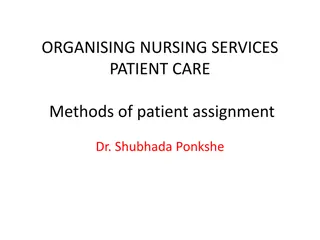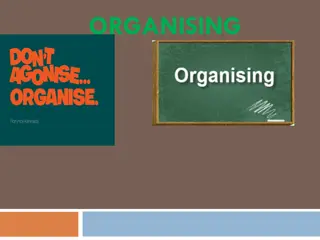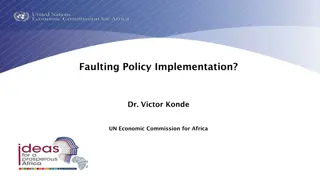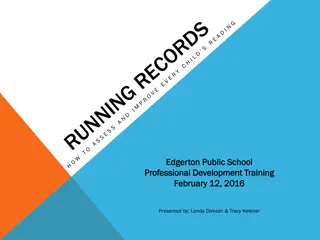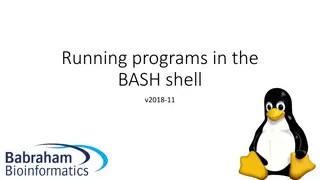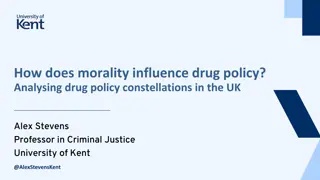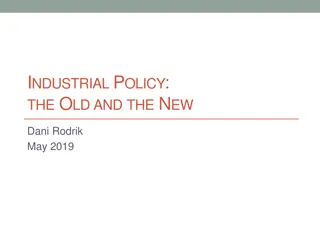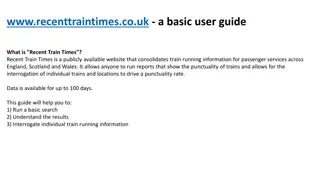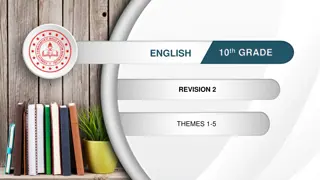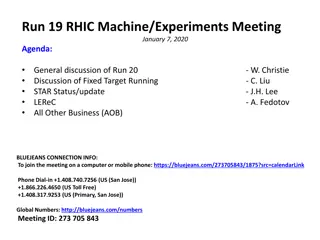Organising and running policy dialogues
Formal discussion and careful consideration are essential in health policy decisions. Policy dialogues provide a structured platform to develop evidence-informed policies, clarify problems, and prioritize solutions while involving stakeholders. Key judgements, complexities, and values must be carefully weighed during and after these dialogues to ensure successful outcomes.
Download Presentation

Please find below an Image/Link to download the presentation.
The content on the website is provided AS IS for your information and personal use only. It may not be sold, licensed, or shared on other websites without obtaining consent from the author. Download presentation by click this link. If you encounter any issues during the download, it is possible that the publisher has removed the file from their server.
E N D
Presentation Transcript
Organising and running policy dialogues What are the objectives? Who will participate? How will the dialogue be organised? What needs to be done following the dialogue? A framework for going from evidence to health systems decisions
Formal discussion and careful consideration before deciding (deliberation) is generally desirable for health policy decisions Deliberative processes are starting to be seen as Providing a promising type of contextualized decision support A way to give voice to stakeholders, including patients and the public Little attention has been paid to the use of deliberative processes to facilitate evidence-informed health policymaking
Policy dialogue A deliberative process (a structured discussion) focused on a policy brief Can contribute to the development of evidence- informed health policies by Adding to the value of the policy brief Helping to clarify the problem and solutions, and develop a shared understanding Contributing to developing and implementing effective policies Contributing to good governance and democracy
Health policy decisions require a great deal of judgement The importance of the problem and its causes Which options to consider to address the problem The likely impacts of those options Barriers to implementing the options Which implementation strategies to consider to address those barriers The likely effects of those strategies Priorities for monitoring and evaluation
Most judgements must be made by those preparing a policy brief and should be open to discussion by those using the policy brief Judgements about the balance between the advantages and disadvantages of the options and implementation strategies that are considered viable need to be made by those using the policy brief and it requires careful consideration of the values that are attached to the expected advantages and disadvantages
The judgements that need to be made are complex They require input from people with different types of expertise and different perspectives The idea of bringing people together to discuss a policy brief is based on the understanding that they all have something to contribute Thus, it is essential that policy dialogues are designed to Bring together an appropriate group of people Use a process that ensures that all participants can be heard and have the opportunity of influencing the outcome of the process
Little is known about the optimal mix of participants in a policy dialogue or how best to structure the discussion to ensure that the objectives of the dialogue are achieved Policy dialogues may have different objectives It is unlikely that there is a single recipe for policy dialogues that is appropriate across different policy briefs and different settings However, a structured approach to deciding on the participants and process can help to ensure that a policy dialogue is appropriately designed to achieve its objectives
What are the objectives of the policy dialogue? Policy dialogues share a common aim: discussion and careful consideration that will contribute to a well- informed health policy decision However, the specific objectives of a policy dialogue can vary in several ways In relationship to the timing of the dialogue and the policy development process The importance of different ways in which it can contribute to the development and implementation of a policy that is evidence- informed The extent to which the aim of the dialogue is to reach a consensus The ways in which the policy dialogue is intended to feed into the policy development process
What is the timing of the dialogue and the policy development process? Policy dialogues may occur at different times in relationship to the policy development process They can occur early in the process The objectives may focus primarily on clarifying and framing the problem and identifying viable solutions And less on the descriptions of options and their implementation They can occur later in the process after the problem and options have been clarified and agreed The focus would likely be primarily on the advantages and disadvantages of the options and implementation strategies that are being considered And less on the problem description and identification of viable options
The timing of the policy development process may also vary There may be an urgent need to address a problem or make a policy decision because of the nature of the problem or a window of opportunity The objective of a policy dialogue might be more focused on contributing towards achieving a consensus and reaching a decision The problem and circumstances may be such that a longer time frame is better suited to the policy development process The objective might be more explorative and focused on contributing towards achieving a process that will result in a good decision and which is perceived as credible
What are the most important ways in which the policy dialogue can contribute to the development and implementation of an evidence-informed policy? While it is unlikely to be helpful to have a long list of objectives, it may be helpful to have a checklist This can be used to help reach agreement on What the most important objectives are To design the dialogue to ensure that priority is given to achieving those objectives Who is invited to participate How the dialogue is organised
Possible objectives Adding to the value of the policy brief Providing a check on the quality and contents of the policy brief Clarifying judgements that were made in the policy brief Introducing relevant evidence not incorporated in the policy brief Helping to ensure that the contents of the policy brief are understandable and understood Helping to ensure that the policy brief is taken into account and used in developing policy
Possible objectives Clarifying the problem and solutions, and developing a shared understanding Further clarifying options for addressing the problem Developing a shared understanding of the pros and cons of different options Identifying and clarifying barriers to implementing the options Identifying and clarifying strategies for addressing those barriers Developing a shared understanding of the pros and cons of relevant implementation strategies Clarify important uncertainties Developing a shared understanding of uncertainties and needs for monitoring and evaluation
Possible objectives Contributing to developing and implementing effective policies Facilitating dialogue among people with different types of expertise and different perspectives Bringing potential opposition into the policy development process Exposing, clarifying or resolving disagreements regarding the evidence Clarifying judgements that need to be made based on the policy brief Clarifying the values used in judgements about the balance between the pros and cons of the options and implementation strategies; and exposing, clarifying or resolving differences in those values Generating ideas and actions by policymakers and stakeholders that can help to expedite development and implementation of effective policies Giving credibility to the policy development process and the policies that evolve
Possible objectives Contributing to good governance and democracy Involving people in their own governance Helping to ensure transparency Helping to ensure accountability Building capacity for evidence-informed policymaking Providing a learning opportunity for stakeholders and the public
How is the policy dialogue intended to feed into the policy development process? Policy dialogues may vary widely in terms of how they are intended to feed into the policy development process At the one extreme, they may be organised by public policymakers to feed formally into a decision At the other extreme, the initiative may come primarily from people without decision-making authority and the policy dialogue may be one of many inputs into the development of a policy The specific objectives and outputs of a policy dialogue (and how it should be designed) will depend on how it is intended to fit into the policy development process
To what extent is it feasible and desirable to achieve a consensus? How desirable it is to achieve a consensus will depend on The timing of the dialogue The most important ways in which it can contribute to evidence- informed policymaking How it is intended to feed into the policy development process If a decision needs to be made urgently, developing a shared understanding of the pros and cons of the options being considered is a high priority, and the policy dialogue is intended to feed directly into a decision, it is more likely that the objective of the dialogue will be to obtain a consensus If a decision does not need to be made urgently, it is early in the policy development process, clarifying and framing the problem and identifying viable solutions are high priorities, and the dialogue is intended to be one of many inputs into the policy development process, obtaining a consensus is unlikely to be important In many situations it could be counter-productive to try to obtain a consensus, although this does not preclude a consensus emerging spontaneously
How will you know if the policy dialogue has achieved its objectives? After agreeing on specific objectives for a policy dialogue, it may be helpful to identify measurable markers of success for each objective These can help to guide what needs to be done following the policy dialogue as well as its evaluation
Questions or comments about the objectives of policy dialogues?
Who will participate in the dialogue? Different political systems may have requirements or traditions regarding which individuals and how many individuals will be invited to meetings to discuss policy issues It may not be possible, or desirable, to deviate from these requirements or traditions But arbitrary or biased selection of participants should be avoided and careful considerations should be given to who will participate in a policy dialogue
A policy dialogue should include people with relevant expertise and perspectives Identifying an appropriate mix of people may require several steps Mapping the range of stakeholders with an interest in the policy issue Mapping the range of expertise that is relevant to the policy issue Identifying individuals that can represent relevant stakeholders and perspectives and have relevant types of expertise Selecting those individuals who will be invited Inviting individuals to participate
Stakeholder mapping Entails creating a list categories of people, groups or organisations with an interest in the specific policy issue Policymakers Including elected officials, political staff and civil servants - in the national government and sub-national governments, and from different departments, and not just health or finance department Managers In districts or regions, healthcare institutions (e.g. hospitals), non-governmental organisations, and other relevant types of organisations Civil society groups Including consumer groups, health professional associations, industry associations, and other relevant groups Researchers In national research institutions, universities, and from other countries
Mapping the range of expertise that is desirable Entails creating a list of the types of expertise for the specific issue Researchers from different disciplines Health professionals from different professions and specialities Civil servants and managers from relevant programmes Professionals and consumers with practical experience People with expertise in political, policy development and group processes
Mapping different factors that need to be understood To ensure that participants bring to the dialogue understanding of a range of factors such as the Regulatory and institutional constraints On-the-ground realities and constraints Values and beliefs of those who will be affected Underlying incentives, and influence and authority within and among key interest groups Social, political and economic factors beyond the health sector that affect the problem and potential solutions International factors that affect the problem and potential solutions, including the influence of donor strategies, actions and aid modalities
A list of individuals representing relevant stakeholders with relevant types of expertise and understanding can then be generated Individuals can be identified by asking relevant stakeholder organisations for nominations Important to specify the types of people that are needed in terms of expertise or perspective and in terms of selection criteria It should be made clear whether participants are being invited to represent An interest group officially or Only themselves
Examples of criteria that can be used to select participants The ability to Articulate the views and experiences of a particular constituency Engage with participants drawn from other constituencies and listen to them Appreciate the value of scientific and other types of evidence and understand the role of evidence in informing decisions Champion the implementation of options to address the problem within their constituencies
It may be helpful to ask for several nominations from each stakeholder group so the most appropriate people can be selected People may fill more than one role E.g. by representing a stakeholder perspective and having relevant expertise and understanding of important factors Or through previous experience, such as health professionals or researchers who have become policymakers or managers First generating a list of individuals and then selecting participants from the list can Facilitate selecting a group with the desired range of perspectives and expertise Allow for consideration of other potentially important characteristics (e.g. geographical representation)
How many participants? Balanced representation of all key constituencies Active participation by everyone The ideal size of a group depends on The range of stakeholders with an interest in the policy issue The nature of the policy issue and the types of expertise that are needed National traditions and culture More than 18 people may create coordination problems and limit the extent to which people are able to participate fully At least two ways of coping with having a larger group Some full participants and others as observers Break up into smaller groups for discussions Important to manage any reporting back Reports back should be succinct and focus on key issues only Assigned rapporteurs can meet during a break and synthesise what came out of the small groups This also facilitates focusing follow-up discussion on issues that most warrant it
Another way of increasing participation while limiting the number of people at the dialogue Ask people who are nominated and who cannot be included (because there are too many nominees or because they are not available) to comment on the policy brief If this is done in advance of the dialogue, relevant comments can be interjected at the dialogue
Once key individuals have been identified, care should be taken to ensure that they are interested and able to participate Select a convenient date Check to ensure that there are not likely to be important conflicts Set the date well in advance Ensure that the dialogue starts and finishes at convenient times Select a convenient location and venue Invite participants well in advance Ensure that the dialogue is convened by relevant organisations Ensure that invitations come from appropriate people Ensure that the invitation letter will appeal to those who are invited
The invitation should be brief and compelling Ensure that the following will appeal to those invited: The organisations that are hosting the dialogue The title of the dialogue How the dialogue will feed into policy development Clear, achievable and relevant objectives The range of people invited to participate The agenda and format for the dialogue The expected outputs of the dialogue In addition, it may help to contact some or all of those invited by telephone
Questions or comments about participants in a policy dialogue?
How will the dialogue be organised? Should optimise the likelihood of successfully achieving the objectives Not a single optimal way of organising a dialogue Consideration should be given to The type of meeting How the discussion will be organised and managed Pre-circulation of materials The agenda Who will facilitate or chair the dialogue The extent to which the dialogue will be open or closed Practical arrangements
Face-to-face meetings are best suited to achieving the objectives of most policy dialogues It may be possible to have a telephone or virtual meeting in addition to a face-to-face meeting This might facilitate involving a wider range of participants or clarifying a specific aspect of the problem or potential solutions
Various degrees of structuring are possible E.g. nominal group technique Collection of ideas from each participant and then their systematic playing back to the group by a facilitator in such a way as to ensure that all ideas are openly addressed Because of the complexity of the issues addressed in most policy dialogues and the objectives, it is likely to be helpful to structure discussions around specific issues, but not to structure each of these discussions E.g. the problem, each option, and implementation considerations Any structure that is used should be designed to maximise contributions from all of the participants and interactions among them It is possible that a structure that explicitly separates consideration of different types of evidence can increase the degree to which the outcomes of the dialogue can be traced back to the evidence
The policy brief should be circulated far enough in advance of the dialogue that participants have time to read it and reflect Generally, at least two weeks should be allowed Sometimes more time may be desirable, for example to allow participants time to consult with their constituencies Other times a dialogue may need to be organised on short notice because of the urgency of the problem or political expediency
Assuming that the policy brief has been read in advance of the meeting and letting participants know that this is expected Allows time for reflection and possibly consultation prior to the dialogue Allows more time for discussion at the dialogue But may sometimes not be reasonable to expect participants to read the policy brief in advance of the meeting
Care should be taken not to overwhelm participants with information The agenda and a list of participants can also be circulated in advance Circulating additional background documents may Distract attention from key information, which should be summarised in the policy brief Discourage careful reading of the policy brief
The agenda Should include a maximum amount of time for interactive discussion and a minimum amount of time for presentations Care should be taken not to talk at participants It may be best not to allow PowerPoint presentations, so as to limit any inclinations to give presentations If it is not assumed that the policy brief has been read, time should be allowed for participants to read at least the executive summary And it may be necessary to introduce each discussion by summarising the key information from the policy brief If it is assumed that the policy brief has been read, far less time is needed to introduce each discussion But it may still be desirable to begin discussions by drawing attention to the relevant key messages and inviting comments on those
The agenda should include deliberation about the problem, each option for addressing the problem, implementation considerations, and next steps It is logical to organise the agenda so that there are separate deliberations about each section of the policy brief There may be reasons to organise the agenda differently E.g. discussing implementation considerations together with each option Depending on the timing and objectives of the dialogue, it may be desirable to give more time to some considerations than others E.g. it may be desirable to spend more time discussing the problem early in the policy development process, if there are conflicting views regarding the problem, of if there are important uncertainties about the problem Conversely, it may be desirable to spend less time discussing the problem and more time discussing solutions, if there is already a shared understanding of the problem
Length of a policy dialogue It is necessary to balance Allowing sufficient time for a fruitful discussion with participation of all of the participants Minimising demands on participants time Between one and two days is likely to be an appropriate length But this may vary depending on The objectives of the dialogue Schedules and travel arrangements for participants The extent of controversy
Chair or facilitator A skilled, knowledgeable and neutral chair or facilitator is required to ensure that the Time that is available is used well Policy dialogue is run well. Experience and skill is needed to Keep the discussions focused on relevant issues Ensure that all participants contribute Probe for the basis of important assumptions that are made without a clear basis Challenge constructively possible misinterpretations of the evidence or the viewpoints of others
Chair or facilitator The facilitator should guard against individual participants dominating the discussion or inappropriately influencing the discussion E.g. by drawing on their perceived authority (e.g. their position or research background), talking too much or cutting off others Some knowledge about the problem and potential solutions and the context is needed to be able to Appropriately interpret contributions and the dynamics of the discussion Determine when and how to intervene Neutrality is necessary to Ensure that all participants feel that their contributions will receive a fair hearing Avoid the dialogue being manipulated or perceived as being manipulated to support a particular viewpoint
Open versus closed dialogues The extent to which the dialogue is open or closed may affect how participants contribute It is necessary to find a balance between transparency and privacy Privacy may be necessary for discussion to flow freely and for participants to be comfortable admitting ignorance, enquiring openly, and trying out ideas Transparency is generally desirable, but may inhibit contributions and encourage playing to the audience One way of balancing these competing needs is to be open on about procedures, while the actual deliberations (apart from any agreed upon outputs) are closed If deliberations are closed, there should be clear rules that are discussed and agreed on at the beginning of the dialogue E.g. the Chatham House Rule states that: Participants are free to use the information received during the meeting, but neither the identity nor the affiliation of the speaker(s), nor that of any other participant, may be revealed. This ensures that participants can use and act on what they have learned while ensuring the privacy that is needed for them to contribute freely and openly
Practical arrangements Decide who is responsible for the practical arrangements Secure a venue that is convenient and conducive to discussion (with break-out rooms, if these are needed) Manage travel arrangements for participants Ensure a suitable seating arrangement (ideally board room style) Make sure that the meeting room is easy to find (e.g. putting up signs or providing instructions, if needed) Arrange for name tags, refreshments, writing materials, translation if needed, etc.
Questions or comments about organising a policy dialogue?
What needs to be done following the policy dialogue? The outcomes of a policy dialogue depend on the objectives and how public (open) the dialogue is Possible actions that may be needed following the dialogue to ensure that its objectives are successfuly met include: Preparing and disseminating a report Disseminating the policy brief Other dissemination activities Further consultation with stakeholders Follow-up on any next steps that were identified Evaluation of the policy dialogue
Report Preparing and disseminating a report with key messages from the policy dialogue is likely to be a minimum criterion for ensuring that the objectives of the dialogue were met If the dialogue was closed, the report needs to respect this E.g. if the Chatham House Rule was used, the report should not include comments that are attributed to identified individuals or to individuals with identified affiliations and the summary should not include a list of dialogue participants
A more detailed report may be desirable Should be agreed in advance If obtaining a consensus was an objective of the dialogue, or if a consensus emerged spontaneously, a consensus statement would likely need to be prepared and disseminated It would be important to have an appropriate process to ensure that participants were in agreement with the statement It would also likely be important to agree that dialogue participants would be named as signators of a consensus statement
Suggestions for preparing a report of a policy dialogue The purpose of a policy dialogue report is to capture the views, opinions, insights and understandings (or misunderstandings) of the individual participants. The target audience may vary, but generally includes policymakers and stakeholders with an interest in the problem both in the country and internationally. Participants in the dialogue should be informed that a report will be prepared. It should be agreed that opinions will be reported without attribution and consent should be given to list the dialogue participants in the report. Careful notes should be kept during the dialogue. Consent should be sought to audio or video record the dialogue, if this is desired.
